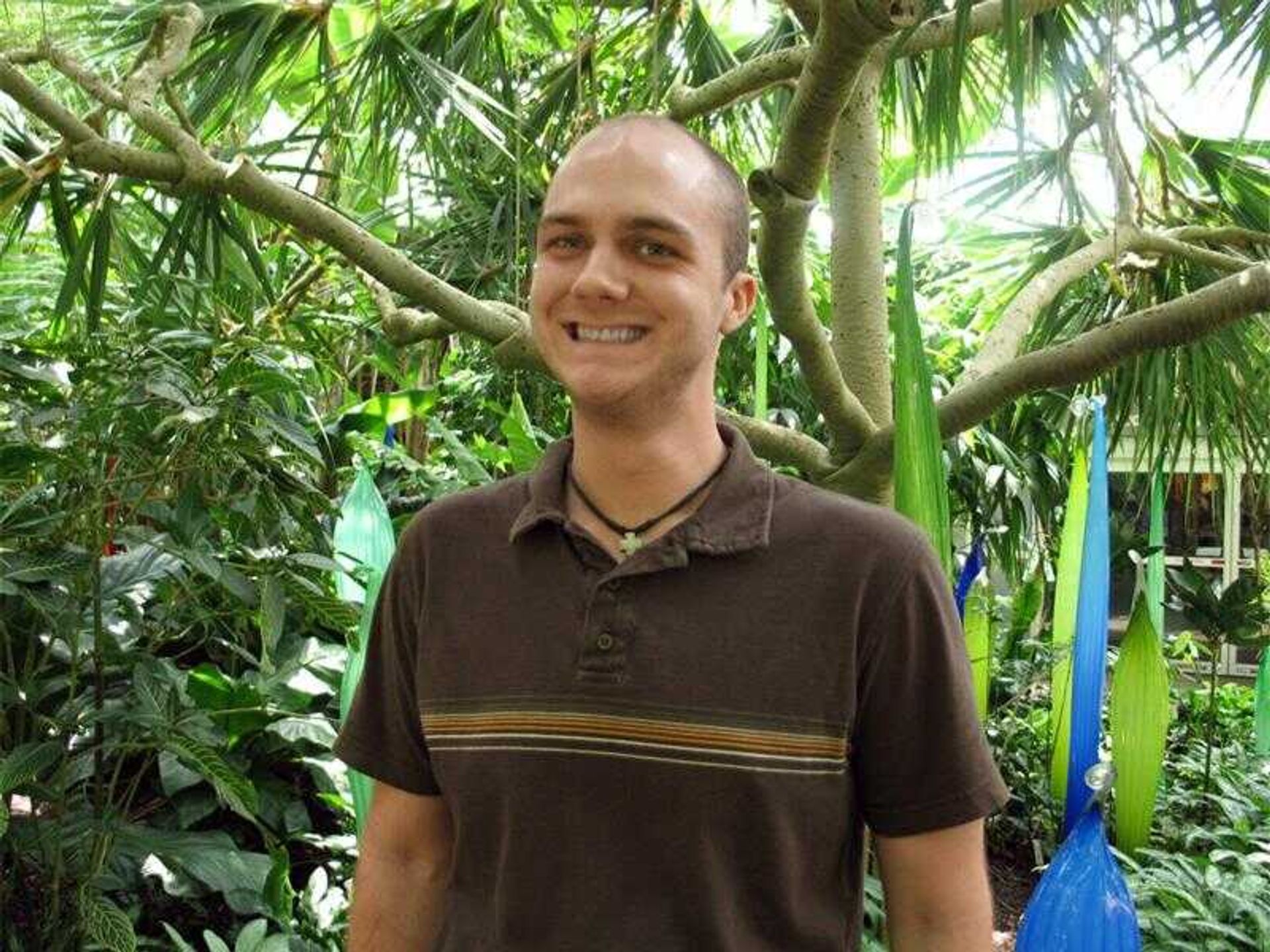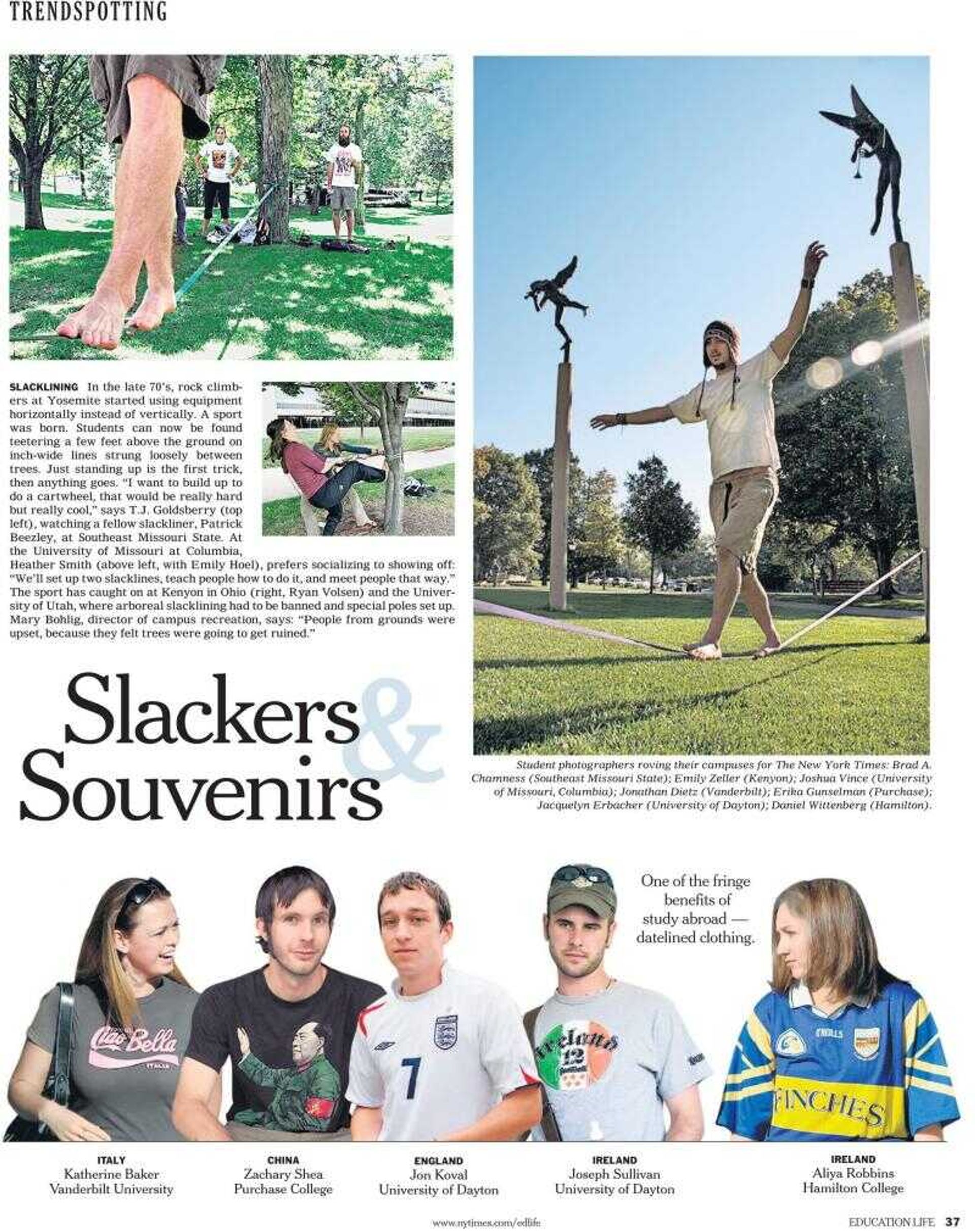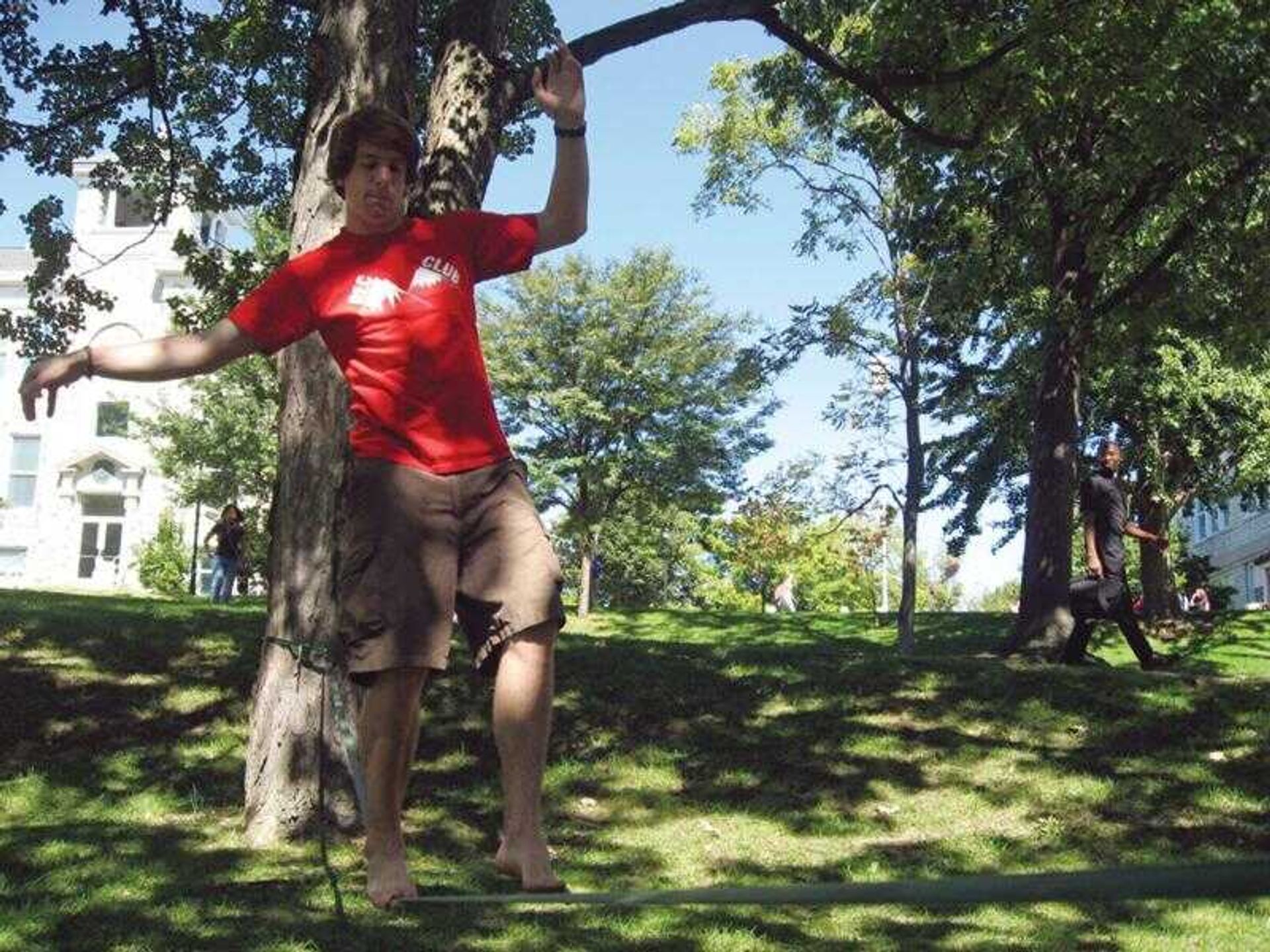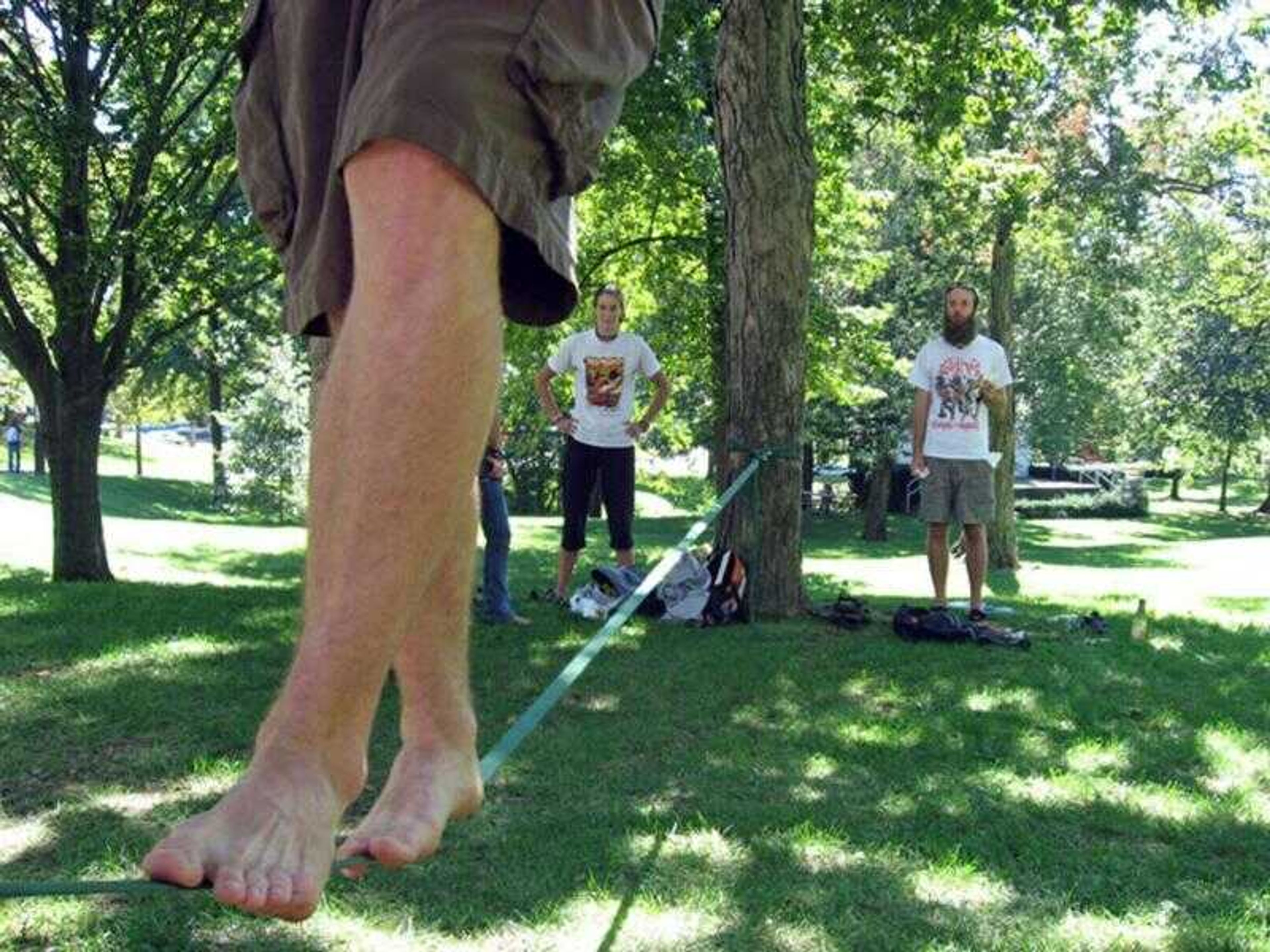A photo Southeast Missouri State University student Brad Chamness took capturing of a fellow student walking several feet above the ground on a piece of webbing stretched between two trees brought him national publicity.
Chamness, 24, a technical graphics major, had a photo of the club sport slacklining published in the New York Times. His photo was displayed in the Trendspotting section of the newspaper, which featured student photographers shooting trends at their college campuses.
Chamness recently answered some questions about his love for photography and his feelings about having his photo published in the New York Times.
Q: Tell us a little bit about yourself. Where are you from? How long have you been attending Southeast?
Brad: I'm originally from Florissant, Mo., but I haven't lived there in 20 years. I've moved around quite a bit, but have come to rest for awhile in Cape Girardeau.

I attend Southeast and in spring 2001, I decided to major in technical graphics. After developing an appreciation for photography in college, I decided I would rather major in photography than making it a hobby. Unfortunately, Southeast didn't have a photography major and only offered one photography class.
I withdrew from the university in spring 2003 with a plan to "work and save money." Saving money -- I later realized -- was not a realistic concept while working in kitchen for a local restaurant.
I returned to Southeast in fall 2005, picking up my technical graphics degree where I left off. Since returning to school, I accepted a position in the Web administration and photography department for University Relations.
I love my job and the people I work with. I'm responsible for arranging photo shoots with university faculty, clubs and various other organizations. The photos are used on Southeast's Web site or in special publications. The pay is what you would expect from a student job, so I pick up some extra hours on the weekends working for the Department of Mental Health at Cottonwood Residential Treatment Center.
Personally, I am in love with the aesthetic beauty of nature. The reason I enjoy nature photography so much is it combines two of the most enjoyable activities in one perfect union -- nature and taking pictures. I also enjoy music and am an avid concertgoer. School is going well, and I've made the president's list for the past three semesters. I will graduate in spring 2008.

Q: How did you become interested in photography? Do you plan to continue this as a career?
Brad: My first real camera came in a bundle with a computer system that I received as a birthday present in 2000 from my mother. It was a 2.0 MP Fuji. I always played with it and was intrigued with it, but the lens just didn't cut it.
During my first semester in college, I took a photography class with Dr. David Baird. The class was at 8 a.m. three-days-a-week and I sometimes fell asleep in the darkroom -- but I loved this class. While enrolled in this class, I bought my first major investment in the increasingly expensive world of photography equipment -- a Canon Rebel 2000 SLR. I currently shoot mostly with my Canon 700IS, but I'm trying to save some money to buy a nice D-SLR.
My lifetime ambition is to be a wildlife photographer for some major sponsor like National Geographic, but I think I would be happy as long as I get paid to be out in the field doing what I love.
Q: Can you explain the New York Times trendspotting piece, which ran in the Nov. 5 newspaper?

Brad: The trendspotting topic for that month was titled "Slackers and Souvenirs." It focused on slacklining, which is a sport that is basically tightrope walking close to the ground. The other topic was about students wearing clothing from other countries they purchased while studying abroad.
College students took the pictures that are published in the trendspotting section. The photo of mine used in the New York Times was taken of Pat Beezley's feet while he was walking across the slackline.
Q: How did you hear about the New York Times accepting photos from college students?
Brad: Our news bureau director Ann Hayes was contacted by someone from the Southeast Recreation Club. A representative from the New York Times had called because they were doing a story on slacklining, and they found out that students on our campus participated in it. They wanted a photographer for the story, and Ann Hayes asked if I would be interested. Of course I said I would. She gave me the e-mail address and I corresponded with them from that point.
Q: Was this a contest? How many others entered? What did you win?
Brad: It wasn't officially a contest, but the original e-mail I received from my contact at the New York Times was addressed to about 10 people, and only three photos were printed.
To my understanding, each of us submitted five photos and three of us received freelance contracts for the photos we submitted. Personal gratification was the major prize here, but they did send me a $200 freelance check.
Q: Do you enter your photography into other contests?
Brad: I haven't entered anything into any contests before, but maybe I will sometime. One thing this experience has shown me is if you actually put forth an effort, there's no telling what's possible. If you had asked me a year ago if I thought I would have anything published anywhere, I would have said no way.
Q: How did you feel about having your photo published in the New York Times?
Brad: It's such a huge thing to happen to someone who has never received any recognition for any of his work before. I realize it's just one photo, but if I concentrate on it as a starting point, I have a feeling I might actually get to do exactly what I want for a living. It's an inspiring thought.
About slacklining
Slacklining is a lot like tight-rope walking, but is almost always done close to the ground and the line you walk across is bouncy. A typical slackline set-up consists of a line of webbing pulled tight between two upright and sturdy objects, preferably trees but telephone poles or vehicles can be used as well.
Slacklining has its origins in rock climbing during the 1980s. Around their campsites at night, climbers came up with the idea of walking on the nylon webbing between posts for fun or as a balancing trick.
Besides enjoying the activity, slackers say walking on webbing helps with concentration or acts as a balancing exercise. Some people use it for meditation, or to bring their balance and concentration to a new level for performance in sports.
Southeast's slacklining club formed last fall and meets at noon Mondays and 11:30 a.m. Tuesdays on the terraces at Academic Hall.
Connect with the Southeast Missourian Newsroom:
For corrections to this story or other insights for the editor, click here. To submit a letter to the editor, click here. To learn about the Southeast Missourian’s AI Policy, click here.








